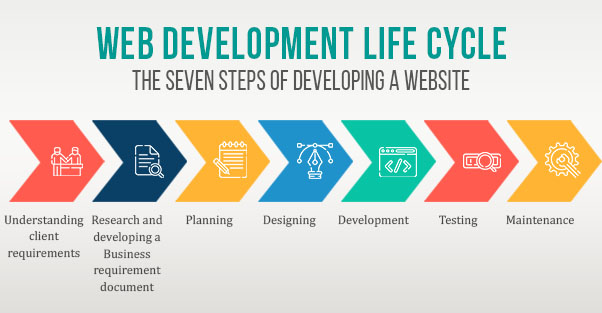Talking about the process, we need to be careful about each step involved in the Web Development life cycle. A step missed will result in an extended timeline, and you will have to face the sequel of the delayed launch of your website. It is often said that the website development process revolves around coding. I can’t entirely agree. There are many steps in developing a web application. This blog will step by step analyze the overall seven-stage approach of the Web development life cycle. In this article, we have listed down an overall seven-stage approach of the Web development life cycle.
Also, Read – Seven Steps For Website Development
The seven steps of developing a website:
- Understanding client requirements
- Research and developing a Business requirement document
- Planning
- Designing
- Development
- Testing
- Maintenance
Understanding client requirements
The most important it involves understanding the requirements of the owner. Identify client needs and help them in providing the perfect solution and clear idea about the target audience. What the business goals are and how the website will be used to fulfil those objectives.
Research and developing a Business requirement document
Every app is different from each-another. Therefore, at this stage, our team research and collect as much information as is relevant to the project. Thus, in-depth research and analysis about the industry, target audience, competitors, project goal, results, etc. We are providing the information and knowledge to develop an impeccable web app.
Planning
Now that we have all the necessary information, the time has come to develop a sitemap. It serves as a guide to the topics and subtopics on the website and helps us determine how useful and easy the final product will be. Therefore, the UI/UX designer follows our best practices to make a mock-up for each type of device (desktop, smartphone, and tablet). It is a visual representation of the user interface, indicating the added elements and their location. We discuss what programming language, content management system (CMS), interactive forms, and frameworks should be implemented during the web development life cycle planning. Choosing a proper technology stack is important for a smooth user experience.
Designing
During the design stage, your website takes shape. All the visible content, such as images, photos, and videos, is created at this step. Once again, all the information gathered through the first phase is important. The customer & target audience should be kept in mind while working on the design. The website layout is the outcome of a designer’s work. It can be a graphic designer. The layout’s primary function is to represent the information structure, visualize the content, and demonstrate the basic functionality. Website Layouts contain colors, logos, images and can give a general knowledge of the future product. After that, the customer can review the website layout and send you their feedback.
Read – Ultimate Tips For User-Friendly Website Design
Development
Once you have done your final website design, the website development process gets technical. This phase includes coding, and your developer’s job is to make your site function properly. Your website developer will create your homepage, followed by the other landing pages based on the website hierarchy. The process also involves mixing all the pre-designed elements and building an actual site.
Testing and Maintenance
Testing is one of the important phases of the web development process. Your developers will check the functionality of all factors on your website. The purpose is to detect any issues such as broken links and compatibility with various devices to ensure everything works properly. They finish manual & automated testing, your website will be ready to go and launch on a live server.
It is vital to remember that a website is more a service than a product. It is not sufficient to “deliver” a website to a user. You should also make sure that everything works well, and everyone is satisfied and always ready to make changes in any other case.
The feedback system added to the site will allow you to detect potential problems facing end-users. The highest priority task, in this case, is to fix the problem as soon as possible. If you don’t, you may one day find that your users prefer to use another website rather than dealing with the inconvenience.
The crucial thing is that your website is up to date. If you use a CMS, regular updates will protect you from bugs and reduce security risks.
Conclusion
Following a system development, the life cycle process makes your work more efficient by breaking it up into individual parts. It would be best if you always kept in mind that the website development project does not start with coding and does not end after the day when you finally launch your website. The preparation stage affects all subsequent stages, defining how productive the development process will be. The seven steps take the customer’s idea from an abstract concept to a complete and functional product. Regardless of the process you choose, having a systematic approach makes website development more organized, streamlined, and easier to evaluate.
